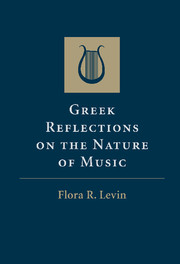Book contents
- Frontmatter
- Contents
- Figures
- Preface
- Introduction
- Abbreviations
- Texts
- 1 All Deep Things Are Song
- 2 We Are All Aristoxenians
- 3 The Discrete and the Continuous
- 4 Magnitudes and Multitudes
- 5 The Topology of Melody
- 6 Aristoxenus of Tarentum and Ptolemaïs of Cyrene
- 7 Aisthēsis and Logos: A Single Continent
- 8 The Infinite and the Infinitesimal
- ΣΦPAΓIΣ
- Bibliography
- Index
8 - The Infinite and the Infinitesimal
Published online by Cambridge University Press: 21 October 2009
- Frontmatter
- Contents
- Figures
- Preface
- Introduction
- Abbreviations
- Texts
- 1 All Deep Things Are Song
- 2 We Are All Aristoxenians
- 3 The Discrete and the Continuous
- 4 Magnitudes and Multitudes
- 5 The Topology of Melody
- 6 Aristoxenus of Tarentum and Ptolemaïs of Cyrene
- 7 Aisthēsis and Logos: A Single Continent
- 8 The Infinite and the Infinitesimal
- ΣΦPAΓIΣ
- Bibliography
- Index
Summary
The phenomena of melody
seem to be infinite with respect
to the sizes of musical intervals
and the pitches of musical notes;
but as to their functions, forms,
and positions, they are finite and prescribed.
Aristoxenus, Harm. El. III. 69in all that pertains to the science of melody, aristoxenus was a man per se, a man who stood very much alone. As a musician, he was an avowed conservative, ever at war with any kind of innovation that he thought of as violating the ancient forms of the musical art. He speaks, for example, of two ancient styles (tropoi) which he regarded as especially beautiful, styles which his contemporaries were, in his eyes, either too ignorant to appreciate, or too avid in their pursuit of a chromatic kind of sweetness even to remember. But these ancient styles had to be preserved at any cost, as he saw it, with all their ethical distinctions intact. He seems, in fact, to have accepted the Damonian-Platonic view that these distinctions were ethical in nature, inasmuch as they appeared to have a decided effect upon the listener. The problem for Aristoxenus, as stated above, was to provide an affinity (oikeiotēs) between all the ancient styles of melody (tropoi), all the pitch ranges of the voice and instruments (tonoi), and all the scales and genera (systēmata and genē) of theory, such that modulations (metabolai) from one style, key, and genus to another could be easily effected. There was one proviso, however: such modulations would be acceptable only if they did not disturb or compromise the characteristic forms of the individual melodic modes, or tropoi.
- Type
- Chapter
- Information
- Greek Reflections on the Nature of Music , pp. 296 - 302Publisher: Cambridge University PressPrint publication year: 2009

